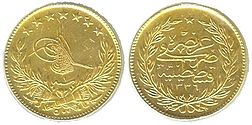- Ottoman lira
-
Ottoman lira ليرا 
5 lira ( 500 kuruş ) coin Official user(s)  Ottoman Empire
Ottoman EmpireUnofficial user(s)  Turkey (until the Turkish Lira started circulating)
Turkey (until the Turkish Lira started circulating)Subunit 1/5 mecidiye or medjidiye 1/100 kuruş 1/4000 para Symbol £ Coins 1, 5, 10, 20, 40 para, 2, 5, 10, 20 kuruş, ¼, ½, 1, 2½, 5 lira Banknotes 1, 5, 10, 20, 40, 50 kuruş, 1, 2, 5, 10, 25, 50, 100, 500, 1000 lira Central bank Ottoman Bank This infobox shows the latest status before this currency was rendered obsolete. The Ottoman lira was the currency of Ottoman Empire between 1844[citation needed] and 29 October 1923[citation needed]. It replaced the kuruş as the principal unit of currency, with the kuruş continuing to circulate as a subdivision of the lira, with 100 kuruş = 1 lira. The para also continued to be used, with 40 para = 1 kuruş. Until the 1930s, the Arabic script was used on Turkish coins and banknotes, with پاره for para, غروش for kuruş and ليرا for lira (تورك ليراسي for "Turkish lira"). In European languages, the kuruş was known as the piastre, whilst the lira was known as the livre in French. Between 1844 and 1881, the lira was on a bimetallic standard, with 1 lira = 6.61519 grams pure gold = 99.8292 grams pure silver. In 1881, the gold standard was adopted and continued until 1914. World War I saw Turkey effectively depart from the gold standard with the gold lira being worth about nine lira in paper money by the early 1920s.
Between 1844 and 1855, coins were introduced in denominations of 1, 5, 10, 20 and 40 para, ½, 1, 2, 5, 10, 20 kuruş, ¼, ½, 1, 2½ and 5 lira. The para denominations were struck in copper, the kuruş in silver and the lira in gold. The 1 para was discontinued in 1859, with the higher copper denominations ceasing production between 1863 and 1879. In 1899, billon 5 and 10 para were introduced, followed by nickel 5, 10, 20 and 40 kuruş in 1910. Gold coins continued to be minted after the abolition of the gold standard, even into the 1920s, but their value far exceeded the value of the equivalent denominations in paper currency.
The Banque Imperiale Ottomane (Imperial Ottoman Bank) first issued paper currency Kaime in 1862, in the denomination of 200 kuruş. The notes bore texts in Turkish and French. Notes for 1, 2 and 5 lira were introduced in 1873. In 1876, smaller denomination notes were introduced for 1, 5, 10, 20, 50 and 100 kuruş. In 1908, 50 and 100 lira notes were introduced.
From 1912, the Ministry of Finance issued paper money. Initially, notes were produced in denominations of 5 and 20 kuruş, ¼, ½, 1 and 5 lira, followed the next year by 1 and 2½ kuruş, 2½, 10, 25, 50, 100 and 500 lira. 1000 lira notes were introduced in 1914. In 1917, postage stamp money was issued in the form of 5 and 10 para stamps affixed to card.
Categories:- Pound (currency)
- Economy of the Ottoman Empire
Wikimedia Foundation. 2010.

